DNA and the law assessment
VerifiedAdded on 2022/08/18
|11
|2765
|19
AI Summary
Contribute Materials
Your contribution can guide someone’s learning journey. Share your
documents today.

Running head: ESSAY
Law7 2017 DNA and the law assessment 3 critical review
Name of the Student
Name of the University
Author Note
Law7 2017 DNA and the law assessment 3 critical review
Name of the Student
Name of the University
Author Note
Secure Best Marks with AI Grader
Need help grading? Try our AI Grader for instant feedback on your assignments.
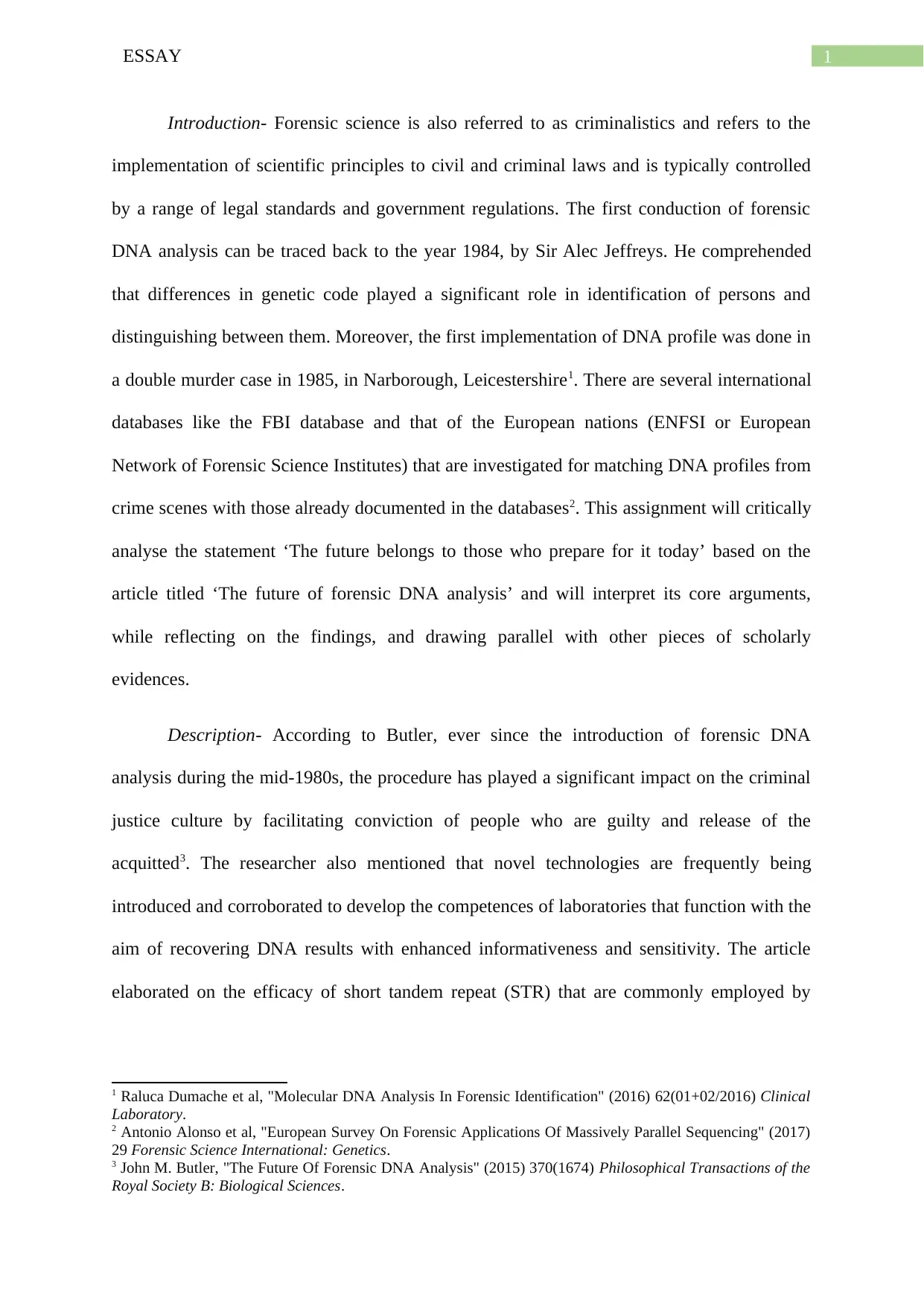
1ESSAY
Introduction- Forensic science is also referred to as criminalistics and refers to the
implementation of scientific principles to civil and criminal laws and is typically controlled
by a range of legal standards and government regulations. The first conduction of forensic
DNA analysis can be traced back to the year 1984, by Sir Alec Jeffreys. He comprehended
that differences in genetic code played a significant role in identification of persons and
distinguishing between them. Moreover, the first implementation of DNA profile was done in
a double murder case in 1985, in Narborough, Leicestershire1. There are several international
databases like the FBI database and that of the European nations (ENFSI or European
Network of Forensic Science Institutes) that are investigated for matching DNA profiles from
crime scenes with those already documented in the databases2. This assignment will critically
analyse the statement ‘The future belongs to those who prepare for it today’ based on the
article titled ‘The future of forensic DNA analysis’ and will interpret its core arguments,
while reflecting on the findings, and drawing parallel with other pieces of scholarly
evidences.
Description- According to Butler, ever since the introduction of forensic DNA
analysis during the mid-1980s, the procedure has played a significant impact on the criminal
justice culture by facilitating conviction of people who are guilty and release of the
acquitted3. The researcher also mentioned that novel technologies are frequently being
introduced and corroborated to develop the competences of laboratories that function with the
aim of recovering DNA results with enhanced informativeness and sensitivity. The article
elaborated on the efficacy of short tandem repeat (STR) that are commonly employed by
1 Raluca Dumache et al, "Molecular DNA Analysis In Forensic Identification" (2016) 62(01+02/2016) Clinical
Laboratory.
2 Antonio Alonso et al, "European Survey On Forensic Applications Of Massively Parallel Sequencing" (2017)
29 Forensic Science International: Genetics.
3 John M. Butler, "The Future Of Forensic DNA Analysis" (2015) 370(1674) Philosophical Transactions of the
Royal Society B: Biological Sciences.
Introduction- Forensic science is also referred to as criminalistics and refers to the
implementation of scientific principles to civil and criminal laws and is typically controlled
by a range of legal standards and government regulations. The first conduction of forensic
DNA analysis can be traced back to the year 1984, by Sir Alec Jeffreys. He comprehended
that differences in genetic code played a significant role in identification of persons and
distinguishing between them. Moreover, the first implementation of DNA profile was done in
a double murder case in 1985, in Narborough, Leicestershire1. There are several international
databases like the FBI database and that of the European nations (ENFSI or European
Network of Forensic Science Institutes) that are investigated for matching DNA profiles from
crime scenes with those already documented in the databases2. This assignment will critically
analyse the statement ‘The future belongs to those who prepare for it today’ based on the
article titled ‘The future of forensic DNA analysis’ and will interpret its core arguments,
while reflecting on the findings, and drawing parallel with other pieces of scholarly
evidences.
Description- According to Butler, ever since the introduction of forensic DNA
analysis during the mid-1980s, the procedure has played a significant impact on the criminal
justice culture by facilitating conviction of people who are guilty and release of the
acquitted3. The researcher also mentioned that novel technologies are frequently being
introduced and corroborated to develop the competences of laboratories that function with the
aim of recovering DNA results with enhanced informativeness and sensitivity. The article
elaborated on the efficacy of short tandem repeat (STR) that are commonly employed by
1 Raluca Dumache et al, "Molecular DNA Analysis In Forensic Identification" (2016) 62(01+02/2016) Clinical
Laboratory.
2 Antonio Alonso et al, "European Survey On Forensic Applications Of Massively Parallel Sequencing" (2017)
29 Forensic Science International: Genetics.
3 John M. Butler, "The Future Of Forensic DNA Analysis" (2015) 370(1674) Philosophical Transactions of the
Royal Society B: Biological Sciences.
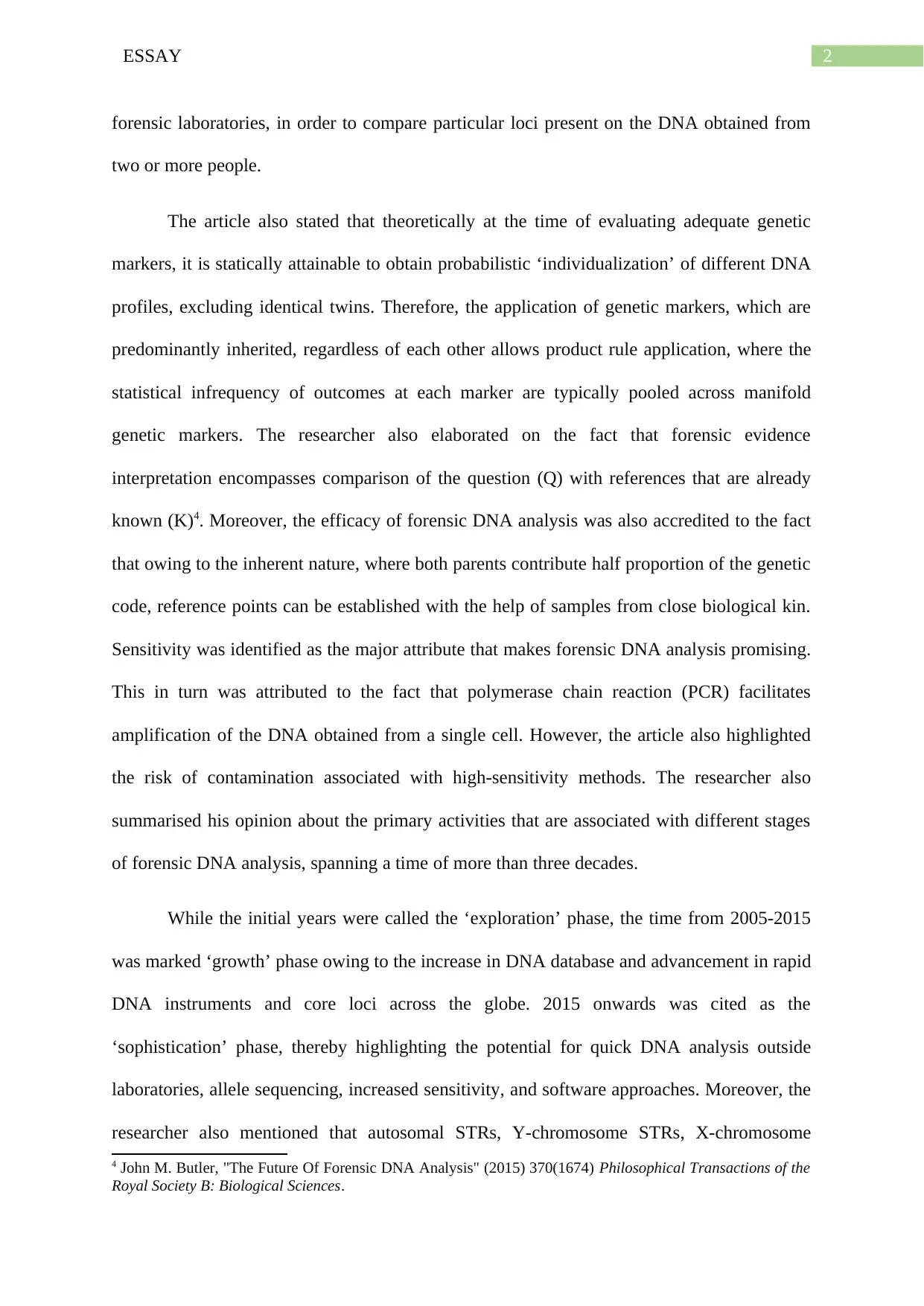
2ESSAY
forensic laboratories, in order to compare particular loci present on the DNA obtained from
two or more people.
The article also stated that theoretically at the time of evaluating adequate genetic
markers, it is statically attainable to obtain probabilistic ‘individualization’ of different DNA
profiles, excluding identical twins. Therefore, the application of genetic markers, which are
predominantly inherited, regardless of each other allows product rule application, where the
statistical infrequency of outcomes at each marker are typically pooled across manifold
genetic markers. The researcher also elaborated on the fact that forensic evidence
interpretation encompasses comparison of the question (Q) with references that are already
known (K)4. Moreover, the efficacy of forensic DNA analysis was also accredited to the fact
that owing to the inherent nature, where both parents contribute half proportion of the genetic
code, reference points can be established with the help of samples from close biological kin.
Sensitivity was identified as the major attribute that makes forensic DNA analysis promising.
This in turn was attributed to the fact that polymerase chain reaction (PCR) facilitates
amplification of the DNA obtained from a single cell. However, the article also highlighted
the risk of contamination associated with high-sensitivity methods. The researcher also
summarised his opinion about the primary activities that are associated with different stages
of forensic DNA analysis, spanning a time of more than three decades.
While the initial years were called the ‘exploration’ phase, the time from 2005-2015
was marked ‘growth’ phase owing to the increase in DNA database and advancement in rapid
DNA instruments and core loci across the globe. 2015 onwards was cited as the
‘sophistication’ phase, thereby highlighting the potential for quick DNA analysis outside
laboratories, allele sequencing, increased sensitivity, and software approaches. Moreover, the
researcher also mentioned that autosomal STRs, Y-chromosome STRs, X-chromosome
4 John M. Butler, "The Future Of Forensic DNA Analysis" (2015) 370(1674) Philosophical Transactions of the
Royal Society B: Biological Sciences.
forensic laboratories, in order to compare particular loci present on the DNA obtained from
two or more people.
The article also stated that theoretically at the time of evaluating adequate genetic
markers, it is statically attainable to obtain probabilistic ‘individualization’ of different DNA
profiles, excluding identical twins. Therefore, the application of genetic markers, which are
predominantly inherited, regardless of each other allows product rule application, where the
statistical infrequency of outcomes at each marker are typically pooled across manifold
genetic markers. The researcher also elaborated on the fact that forensic evidence
interpretation encompasses comparison of the question (Q) with references that are already
known (K)4. Moreover, the efficacy of forensic DNA analysis was also accredited to the fact
that owing to the inherent nature, where both parents contribute half proportion of the genetic
code, reference points can be established with the help of samples from close biological kin.
Sensitivity was identified as the major attribute that makes forensic DNA analysis promising.
This in turn was attributed to the fact that polymerase chain reaction (PCR) facilitates
amplification of the DNA obtained from a single cell. However, the article also highlighted
the risk of contamination associated with high-sensitivity methods. The researcher also
summarised his opinion about the primary activities that are associated with different stages
of forensic DNA analysis, spanning a time of more than three decades.
While the initial years were called the ‘exploration’ phase, the time from 2005-2015
was marked ‘growth’ phase owing to the increase in DNA database and advancement in rapid
DNA instruments and core loci across the globe. 2015 onwards was cited as the
‘sophistication’ phase, thereby highlighting the potential for quick DNA analysis outside
laboratories, allele sequencing, increased sensitivity, and software approaches. Moreover, the
researcher also mentioned that autosomal STRs, Y-chromosome STRs, X-chromosome
4 John M. Butler, "The Future Of Forensic DNA Analysis" (2015) 370(1674) Philosophical Transactions of the
Royal Society B: Biological Sciences.
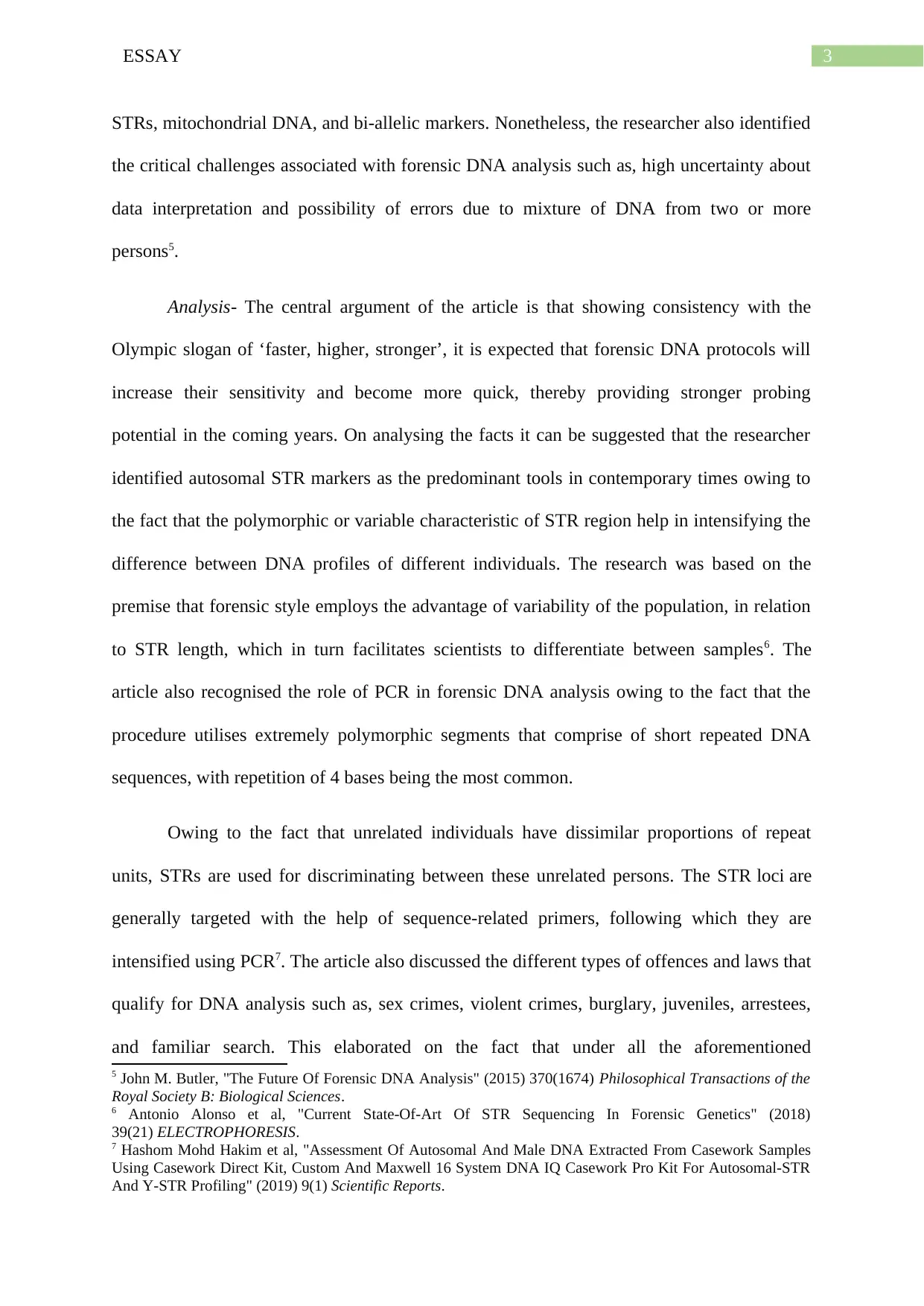
3ESSAY
STRs, mitochondrial DNA, and bi-allelic markers. Nonetheless, the researcher also identified
the critical challenges associated with forensic DNA analysis such as, high uncertainty about
data interpretation and possibility of errors due to mixture of DNA from two or more
persons5.
Analysis- The central argument of the article is that showing consistency with the
Olympic slogan of ‘faster, higher, stronger’, it is expected that forensic DNA protocols will
increase their sensitivity and become more quick, thereby providing stronger probing
potential in the coming years. On analysing the facts it can be suggested that the researcher
identified autosomal STR markers as the predominant tools in contemporary times owing to
the fact that the polymorphic or variable characteristic of STR region help in intensifying the
difference between DNA profiles of different individuals. The research was based on the
premise that forensic style employs the advantage of variability of the population, in relation
to STR length, which in turn facilitates scientists to differentiate between samples6. The
article also recognised the role of PCR in forensic DNA analysis owing to the fact that the
procedure utilises extremely polymorphic segments that comprise of short repeated DNA
sequences, with repetition of 4 bases being the most common.
Owing to the fact that unrelated individuals have dissimilar proportions of repeat
units, STRs are used for discriminating between these unrelated persons. The STR loci are
generally targeted with the help of sequence-related primers, following which they are
intensified using PCR7. The article also discussed the different types of offences and laws that
qualify for DNA analysis such as, sex crimes, violent crimes, burglary, juveniles, arrestees,
and familiar search. This elaborated on the fact that under all the aforementioned
5 John M. Butler, "The Future Of Forensic DNA Analysis" (2015) 370(1674) Philosophical Transactions of the
Royal Society B: Biological Sciences.
6 Antonio Alonso et al, "Current State-Of-Art Of STR Sequencing In Forensic Genetics" (2018)
39(21) ELECTROPHORESIS.
7 Hashom Mohd Hakim et al, "Assessment Of Autosomal And Male DNA Extracted From Casework Samples
Using Casework Direct Kit, Custom And Maxwell 16 System DNA IQ Casework Pro Kit For Autosomal-STR
And Y-STR Profiling" (2019) 9(1) Scientific Reports.
STRs, mitochondrial DNA, and bi-allelic markers. Nonetheless, the researcher also identified
the critical challenges associated with forensic DNA analysis such as, high uncertainty about
data interpretation and possibility of errors due to mixture of DNA from two or more
persons5.
Analysis- The central argument of the article is that showing consistency with the
Olympic slogan of ‘faster, higher, stronger’, it is expected that forensic DNA protocols will
increase their sensitivity and become more quick, thereby providing stronger probing
potential in the coming years. On analysing the facts it can be suggested that the researcher
identified autosomal STR markers as the predominant tools in contemporary times owing to
the fact that the polymorphic or variable characteristic of STR region help in intensifying the
difference between DNA profiles of different individuals. The research was based on the
premise that forensic style employs the advantage of variability of the population, in relation
to STR length, which in turn facilitates scientists to differentiate between samples6. The
article also recognised the role of PCR in forensic DNA analysis owing to the fact that the
procedure utilises extremely polymorphic segments that comprise of short repeated DNA
sequences, with repetition of 4 bases being the most common.
Owing to the fact that unrelated individuals have dissimilar proportions of repeat
units, STRs are used for discriminating between these unrelated persons. The STR loci are
generally targeted with the help of sequence-related primers, following which they are
intensified using PCR7. The article also discussed the different types of offences and laws that
qualify for DNA analysis such as, sex crimes, violent crimes, burglary, juveniles, arrestees,
and familiar search. This elaborated on the fact that under all the aforementioned
5 John M. Butler, "The Future Of Forensic DNA Analysis" (2015) 370(1674) Philosophical Transactions of the
Royal Society B: Biological Sciences.
6 Antonio Alonso et al, "Current State-Of-Art Of STR Sequencing In Forensic Genetics" (2018)
39(21) ELECTROPHORESIS.
7 Hashom Mohd Hakim et al, "Assessment Of Autosomal And Male DNA Extracted From Casework Samples
Using Casework Direct Kit, Custom And Maxwell 16 System DNA IQ Casework Pro Kit For Autosomal-STR
And Y-STR Profiling" (2019) 9(1) Scientific Reports.
Secure Best Marks with AI Grader
Need help grading? Try our AI Grader for instant feedback on your assignments.
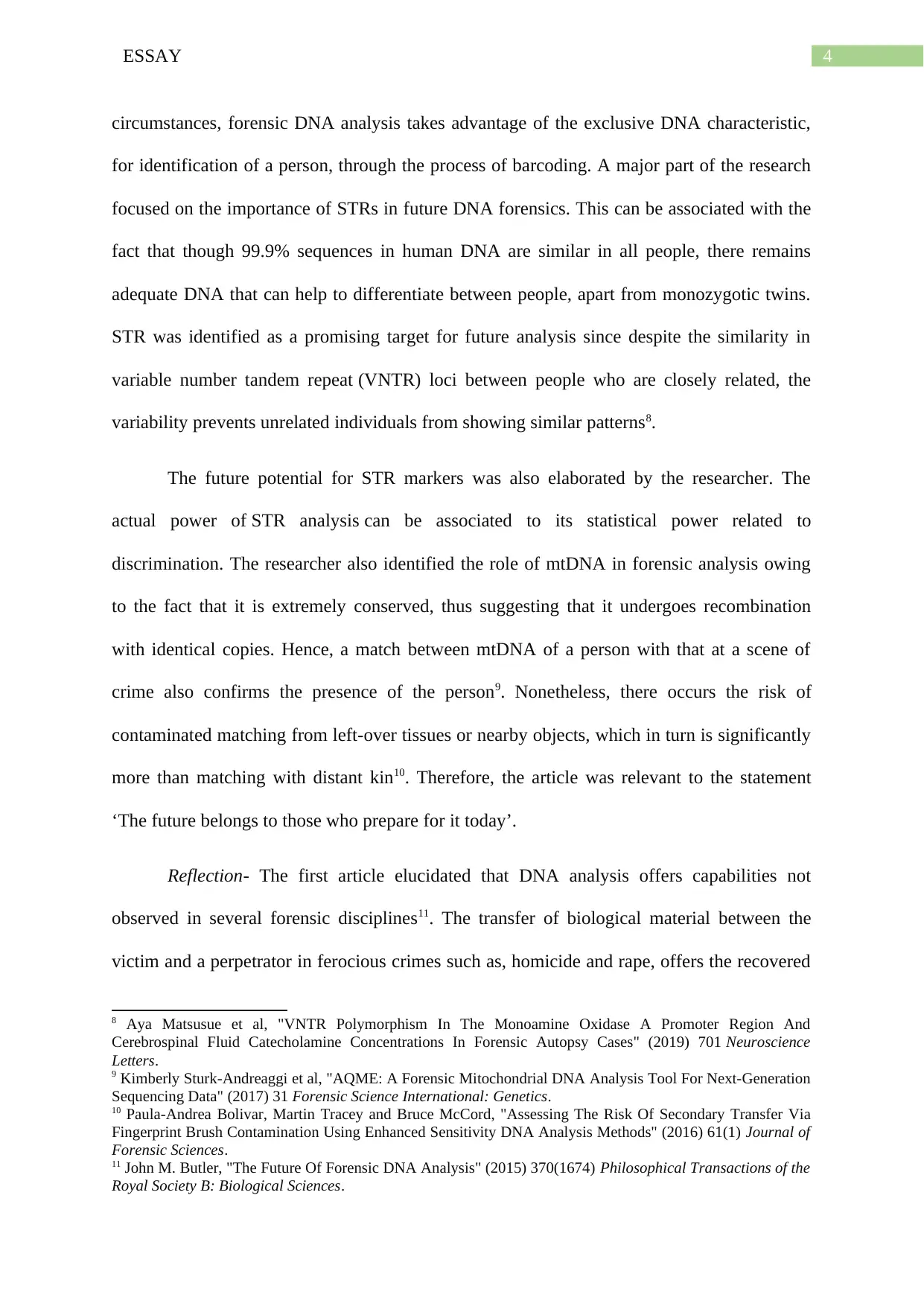
4ESSAY
circumstances, forensic DNA analysis takes advantage of the exclusive DNA characteristic,
for identification of a person, through the process of barcoding. A major part of the research
focused on the importance of STRs in future DNA forensics. This can be associated with the
fact that though 99.9% sequences in human DNA are similar in all people, there remains
adequate DNA that can help to differentiate between people, apart from monozygotic twins.
STR was identified as a promising target for future analysis since despite the similarity in
variable number tandem repeat (VNTR) loci between people who are closely related, the
variability prevents unrelated individuals from showing similar patterns8.
The future potential for STR markers was also elaborated by the researcher. The
actual power of STR analysis can be associated to its statistical power related to
discrimination. The researcher also identified the role of mtDNA in forensic analysis owing
to the fact that it is extremely conserved, thus suggesting that it undergoes recombination
with identical copies. Hence, a match between mtDNA of a person with that at a scene of
crime also confirms the presence of the person9. Nonetheless, there occurs the risk of
contaminated matching from left-over tissues or nearby objects, which in turn is significantly
more than matching with distant kin10. Therefore, the article was relevant to the statement
‘The future belongs to those who prepare for it today’.
Reflection- The first article elucidated that DNA analysis offers capabilities not
observed in several forensic disciplines11. The transfer of biological material between the
victim and a perpetrator in ferocious crimes such as, homicide and rape, offers the recovered
8 Aya Matsusue et al, "VNTR Polymorphism In The Monoamine Oxidase A Promoter Region And
Cerebrospinal Fluid Catecholamine Concentrations In Forensic Autopsy Cases" (2019) 701 Neuroscience
Letters.
9 Kimberly Sturk-Andreaggi et al, "AQME: A Forensic Mitochondrial DNA Analysis Tool For Next-Generation
Sequencing Data" (2017) 31 Forensic Science International: Genetics.
10 Paula-Andrea Bolivar, Martin Tracey and Bruce McCord, "Assessing The Risk Of Secondary Transfer Via
Fingerprint Brush Contamination Using Enhanced Sensitivity DNA Analysis Methods" (2016) 61(1) Journal of
Forensic Sciences.
11 John M. Butler, "The Future Of Forensic DNA Analysis" (2015) 370(1674) Philosophical Transactions of the
Royal Society B: Biological Sciences.
circumstances, forensic DNA analysis takes advantage of the exclusive DNA characteristic,
for identification of a person, through the process of barcoding. A major part of the research
focused on the importance of STRs in future DNA forensics. This can be associated with the
fact that though 99.9% sequences in human DNA are similar in all people, there remains
adequate DNA that can help to differentiate between people, apart from monozygotic twins.
STR was identified as a promising target for future analysis since despite the similarity in
variable number tandem repeat (VNTR) loci between people who are closely related, the
variability prevents unrelated individuals from showing similar patterns8.
The future potential for STR markers was also elaborated by the researcher. The
actual power of STR analysis can be associated to its statistical power related to
discrimination. The researcher also identified the role of mtDNA in forensic analysis owing
to the fact that it is extremely conserved, thus suggesting that it undergoes recombination
with identical copies. Hence, a match between mtDNA of a person with that at a scene of
crime also confirms the presence of the person9. Nonetheless, there occurs the risk of
contaminated matching from left-over tissues or nearby objects, which in turn is significantly
more than matching with distant kin10. Therefore, the article was relevant to the statement
‘The future belongs to those who prepare for it today’.
Reflection- The first article elucidated that DNA analysis offers capabilities not
observed in several forensic disciplines11. The transfer of biological material between the
victim and a perpetrator in ferocious crimes such as, homicide and rape, offers the recovered
8 Aya Matsusue et al, "VNTR Polymorphism In The Monoamine Oxidase A Promoter Region And
Cerebrospinal Fluid Catecholamine Concentrations In Forensic Autopsy Cases" (2019) 701 Neuroscience
Letters.
9 Kimberly Sturk-Andreaggi et al, "AQME: A Forensic Mitochondrial DNA Analysis Tool For Next-Generation
Sequencing Data" (2017) 31 Forensic Science International: Genetics.
10 Paula-Andrea Bolivar, Martin Tracey and Bruce McCord, "Assessing The Risk Of Secondary Transfer Via
Fingerprint Brush Contamination Using Enhanced Sensitivity DNA Analysis Methods" (2016) 61(1) Journal of
Forensic Sciences.
11 John M. Butler, "The Future Of Forensic DNA Analysis" (2015) 370(1674) Philosophical Transactions of the
Royal Society B: Biological Sciences.
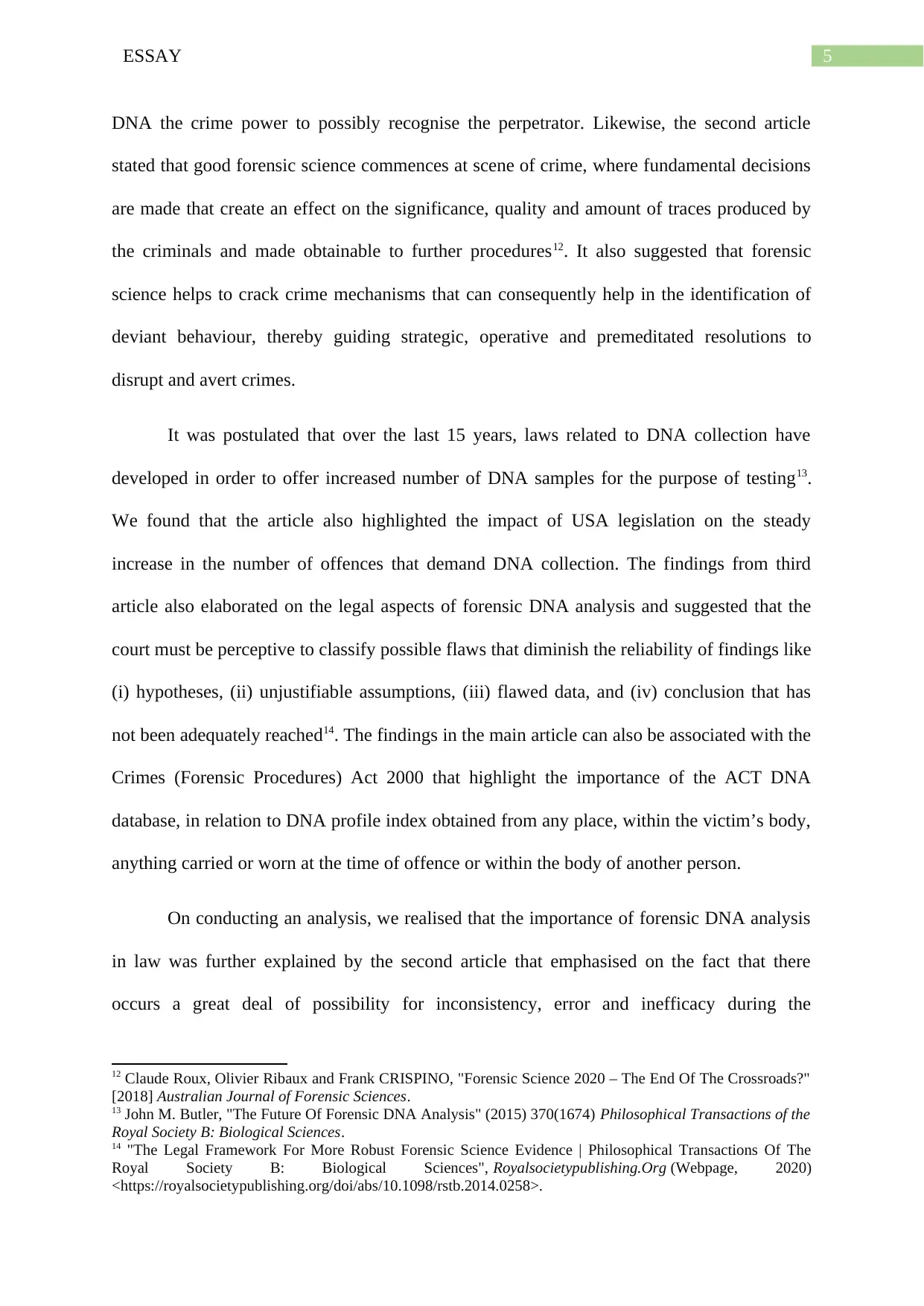
5ESSAY
DNA the crime power to possibly recognise the perpetrator. Likewise, the second article
stated that good forensic science commences at scene of crime, where fundamental decisions
are made that create an effect on the significance, quality and amount of traces produced by
the criminals and made obtainable to further procedures12. It also suggested that forensic
science helps to crack crime mechanisms that can consequently help in the identification of
deviant behaviour, thereby guiding strategic, operative and premeditated resolutions to
disrupt and avert crimes.
It was postulated that over the last 15 years, laws related to DNA collection have
developed in order to offer increased number of DNA samples for the purpose of testing13.
We found that the article also highlighted the impact of USA legislation on the steady
increase in the number of offences that demand DNA collection. The findings from third
article also elaborated on the legal aspects of forensic DNA analysis and suggested that the
court must be perceptive to classify possible flaws that diminish the reliability of findings like
(i) hypotheses, (ii) unjustifiable assumptions, (iii) flawed data, and (iv) conclusion that has
not been adequately reached14. The findings in the main article can also be associated with the
Crimes (Forensic Procedures) Act 2000 that highlight the importance of the ACT DNA
database, in relation to DNA profile index obtained from any place, within the victim’s body,
anything carried or worn at the time of offence or within the body of another person.
On conducting an analysis, we realised that the importance of forensic DNA analysis
in law was further explained by the second article that emphasised on the fact that there
occurs a great deal of possibility for inconsistency, error and inefficacy during the
12 Claude Roux, Olivier Ribaux and Frank CRISPINO, "Forensic Science 2020 – The End Of The Crossroads?"
[2018] Australian Journal of Forensic Sciences.
13 John M. Butler, "The Future Of Forensic DNA Analysis" (2015) 370(1674) Philosophical Transactions of the
Royal Society B: Biological Sciences.
14 "The Legal Framework For More Robust Forensic Science Evidence | Philosophical Transactions Of The
Royal Society B: Biological Sciences", Royalsocietypublishing.Org (Webpage, 2020)
<https://royalsocietypublishing.org/doi/abs/10.1098/rstb.2014.0258>.
DNA the crime power to possibly recognise the perpetrator. Likewise, the second article
stated that good forensic science commences at scene of crime, where fundamental decisions
are made that create an effect on the significance, quality and amount of traces produced by
the criminals and made obtainable to further procedures12. It also suggested that forensic
science helps to crack crime mechanisms that can consequently help in the identification of
deviant behaviour, thereby guiding strategic, operative and premeditated resolutions to
disrupt and avert crimes.
It was postulated that over the last 15 years, laws related to DNA collection have
developed in order to offer increased number of DNA samples for the purpose of testing13.
We found that the article also highlighted the impact of USA legislation on the steady
increase in the number of offences that demand DNA collection. The findings from third
article also elaborated on the legal aspects of forensic DNA analysis and suggested that the
court must be perceptive to classify possible flaws that diminish the reliability of findings like
(i) hypotheses, (ii) unjustifiable assumptions, (iii) flawed data, and (iv) conclusion that has
not been adequately reached14. The findings in the main article can also be associated with the
Crimes (Forensic Procedures) Act 2000 that highlight the importance of the ACT DNA
database, in relation to DNA profile index obtained from any place, within the victim’s body,
anything carried or worn at the time of offence or within the body of another person.
On conducting an analysis, we realised that the importance of forensic DNA analysis
in law was further explained by the second article that emphasised on the fact that there
occurs a great deal of possibility for inconsistency, error and inefficacy during the
12 Claude Roux, Olivier Ribaux and Frank CRISPINO, "Forensic Science 2020 – The End Of The Crossroads?"
[2018] Australian Journal of Forensic Sciences.
13 John M. Butler, "The Future Of Forensic DNA Analysis" (2015) 370(1674) Philosophical Transactions of the
Royal Society B: Biological Sciences.
14 "The Legal Framework For More Robust Forensic Science Evidence | Philosophical Transactions Of The
Royal Society B: Biological Sciences", Royalsocietypublishing.Org (Webpage, 2020)
<https://royalsocietypublishing.org/doi/abs/10.1098/rstb.2014.0258>.
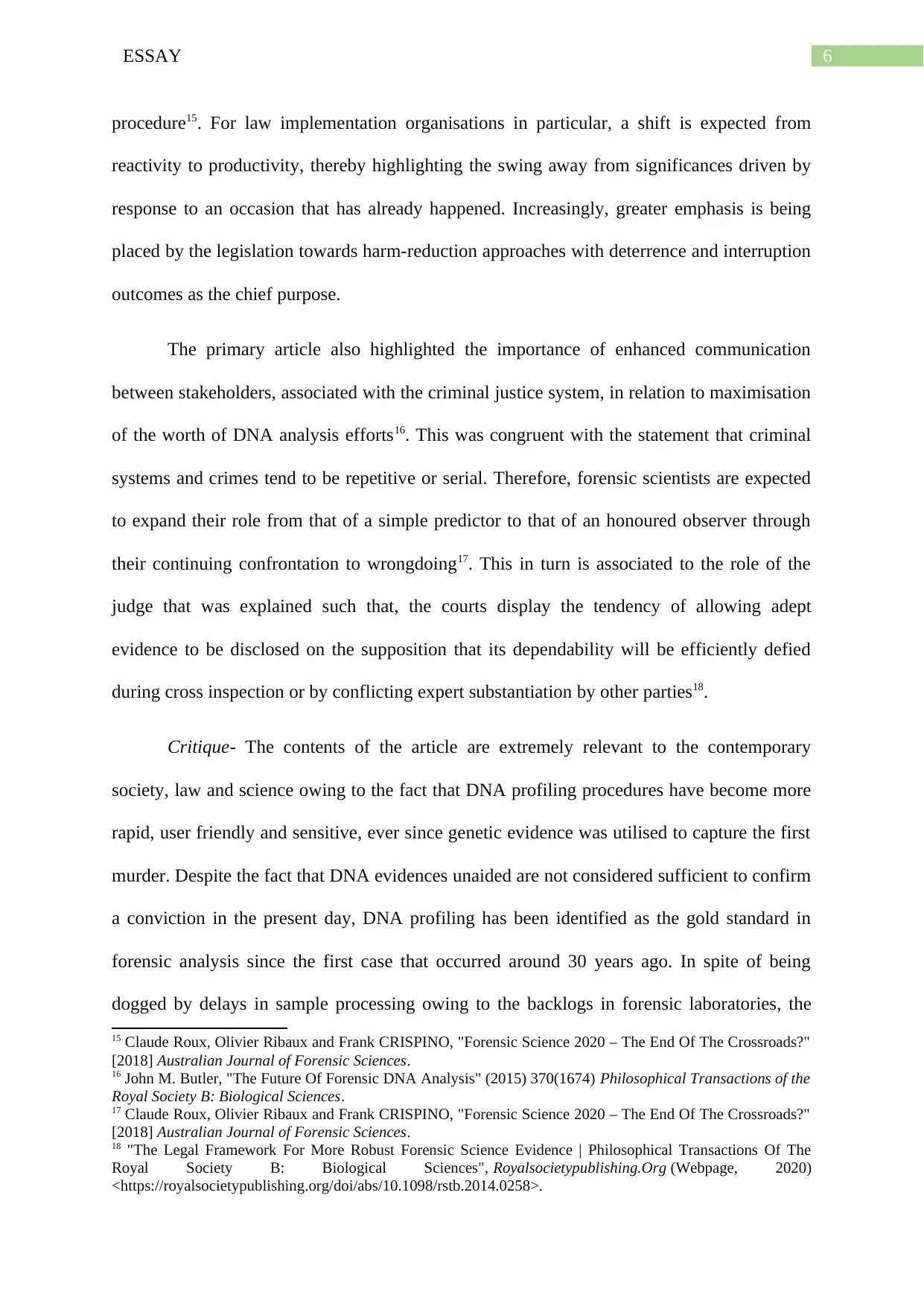
6ESSAY
procedure15. For law implementation organisations in particular, a shift is expected from
reactivity to productivity, thereby highlighting the swing away from significances driven by
response to an occasion that has already happened. Increasingly, greater emphasis is being
placed by the legislation towards harm-reduction approaches with deterrence and interruption
outcomes as the chief purpose.
The primary article also highlighted the importance of enhanced communication
between stakeholders, associated with the criminal justice system, in relation to maximisation
of the worth of DNA analysis efforts16. This was congruent with the statement that criminal
systems and crimes tend to be repetitive or serial. Therefore, forensic scientists are expected
to expand their role from that of a simple predictor to that of an honoured observer through
their continuing confrontation to wrongdoing17. This in turn is associated to the role of the
judge that was explained such that, the courts display the tendency of allowing adept
evidence to be disclosed on the supposition that its dependability will be efficiently defied
during cross inspection or by conflicting expert substantiation by other parties18.
Critique- The contents of the article are extremely relevant to the contemporary
society, law and science owing to the fact that DNA profiling procedures have become more
rapid, user friendly and sensitive, ever since genetic evidence was utilised to capture the first
murder. Despite the fact that DNA evidences unaided are not considered sufficient to confirm
a conviction in the present day, DNA profiling has been identified as the gold standard in
forensic analysis since the first case that occurred around 30 years ago. In spite of being
dogged by delays in sample processing owing to the backlogs in forensic laboratories, the
15 Claude Roux, Olivier Ribaux and Frank CRISPINO, "Forensic Science 2020 – The End Of The Crossroads?"
[2018] Australian Journal of Forensic Sciences.
16 John M. Butler, "The Future Of Forensic DNA Analysis" (2015) 370(1674) Philosophical Transactions of the
Royal Society B: Biological Sciences.
17 Claude Roux, Olivier Ribaux and Frank CRISPINO, "Forensic Science 2020 – The End Of The Crossroads?"
[2018] Australian Journal of Forensic Sciences.
18 "The Legal Framework For More Robust Forensic Science Evidence | Philosophical Transactions Of The
Royal Society B: Biological Sciences", Royalsocietypublishing.Org (Webpage, 2020)
<https://royalsocietypublishing.org/doi/abs/10.1098/rstb.2014.0258>.
procedure15. For law implementation organisations in particular, a shift is expected from
reactivity to productivity, thereby highlighting the swing away from significances driven by
response to an occasion that has already happened. Increasingly, greater emphasis is being
placed by the legislation towards harm-reduction approaches with deterrence and interruption
outcomes as the chief purpose.
The primary article also highlighted the importance of enhanced communication
between stakeholders, associated with the criminal justice system, in relation to maximisation
of the worth of DNA analysis efforts16. This was congruent with the statement that criminal
systems and crimes tend to be repetitive or serial. Therefore, forensic scientists are expected
to expand their role from that of a simple predictor to that of an honoured observer through
their continuing confrontation to wrongdoing17. This in turn is associated to the role of the
judge that was explained such that, the courts display the tendency of allowing adept
evidence to be disclosed on the supposition that its dependability will be efficiently defied
during cross inspection or by conflicting expert substantiation by other parties18.
Critique- The contents of the article are extremely relevant to the contemporary
society, law and science owing to the fact that DNA profiling procedures have become more
rapid, user friendly and sensitive, ever since genetic evidence was utilised to capture the first
murder. Despite the fact that DNA evidences unaided are not considered sufficient to confirm
a conviction in the present day, DNA profiling has been identified as the gold standard in
forensic analysis since the first case that occurred around 30 years ago. In spite of being
dogged by delays in sample processing owing to the backlogs in forensic laboratories, the
15 Claude Roux, Olivier Ribaux and Frank CRISPINO, "Forensic Science 2020 – The End Of The Crossroads?"
[2018] Australian Journal of Forensic Sciences.
16 John M. Butler, "The Future Of Forensic DNA Analysis" (2015) 370(1674) Philosophical Transactions of the
Royal Society B: Biological Sciences.
17 Claude Roux, Olivier Ribaux and Frank CRISPINO, "Forensic Science 2020 – The End Of The Crossroads?"
[2018] Australian Journal of Forensic Sciences.
18 "The Legal Framework For More Robust Forensic Science Evidence | Philosophical Transactions Of The
Royal Society B: Biological Sciences", Royalsocietypublishing.Org (Webpage, 2020)
<https://royalsocietypublishing.org/doi/abs/10.1098/rstb.2014.0258>.
Paraphrase This Document
Need a fresh take? Get an instant paraphrase of this document with our AI Paraphraser
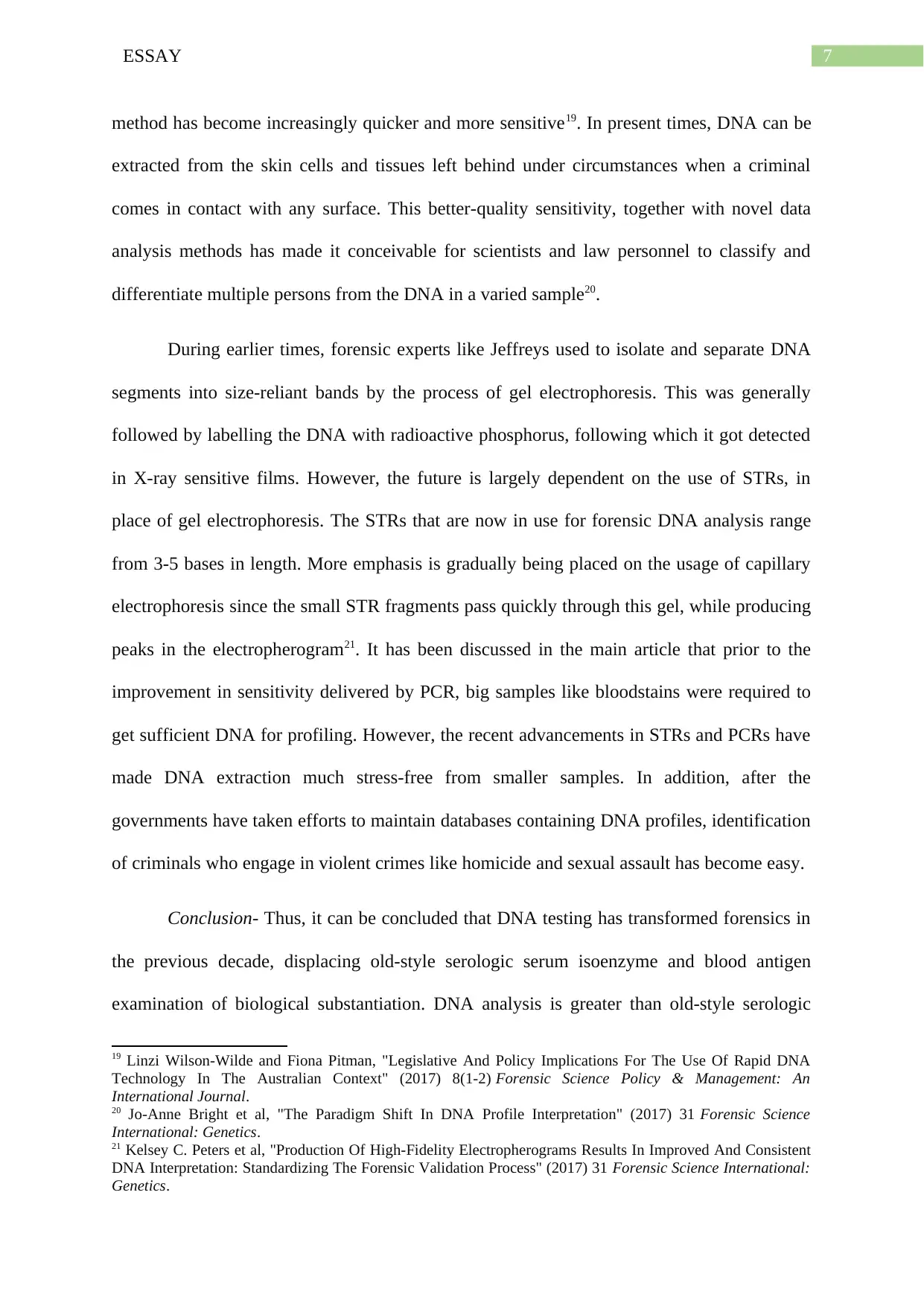
7ESSAY
method has become increasingly quicker and more sensitive19. In present times, DNA can be
extracted from the skin cells and tissues left behind under circumstances when a criminal
comes in contact with any surface. This better-quality sensitivity, together with novel data
analysis methods has made it conceivable for scientists and law personnel to classify and
differentiate multiple persons from the DNA in a varied sample20.
During earlier times, forensic experts like Jeffreys used to isolate and separate DNA
segments into size-reliant bands by the process of gel electrophoresis. This was generally
followed by labelling the DNA with radioactive phosphorus, following which it got detected
in X-ray sensitive films. However, the future is largely dependent on the use of STRs, in
place of gel electrophoresis. The STRs that are now in use for forensic DNA analysis range
from 3-5 bases in length. More emphasis is gradually being placed on the usage of capillary
electrophoresis since the small STR fragments pass quickly through this gel, while producing
peaks in the electropherogram21. It has been discussed in the main article that prior to the
improvement in sensitivity delivered by PCR, big samples like bloodstains were required to
get sufficient DNA for profiling. However, the recent advancements in STRs and PCRs have
made DNA extraction much stress-free from smaller samples. In addition, after the
governments have taken efforts to maintain databases containing DNA profiles, identification
of criminals who engage in violent crimes like homicide and sexual assault has become easy.
Conclusion- Thus, it can be concluded that DNA testing has transformed forensics in
the previous decade, displacing old-style serologic serum isoenzyme and blood antigen
examination of biological substantiation. DNA analysis is greater than old-style serologic
19 Linzi Wilson-Wilde and Fiona Pitman, "Legislative And Policy Implications For The Use Of Rapid DNA
Technology In The Australian Context" (2017) 8(1-2) Forensic Science Policy & Management: An
International Journal.
20 Jo-Anne Bright et al, "The Paradigm Shift In DNA Profile Interpretation" (2017) 31 Forensic Science
International: Genetics.
21 Kelsey C. Peters et al, "Production Of High-Fidelity Electropherograms Results In Improved And Consistent
DNA Interpretation: Standardizing The Forensic Validation Process" (2017) 31 Forensic Science International:
Genetics.
method has become increasingly quicker and more sensitive19. In present times, DNA can be
extracted from the skin cells and tissues left behind under circumstances when a criminal
comes in contact with any surface. This better-quality sensitivity, together with novel data
analysis methods has made it conceivable for scientists and law personnel to classify and
differentiate multiple persons from the DNA in a varied sample20.
During earlier times, forensic experts like Jeffreys used to isolate and separate DNA
segments into size-reliant bands by the process of gel electrophoresis. This was generally
followed by labelling the DNA with radioactive phosphorus, following which it got detected
in X-ray sensitive films. However, the future is largely dependent on the use of STRs, in
place of gel electrophoresis. The STRs that are now in use for forensic DNA analysis range
from 3-5 bases in length. More emphasis is gradually being placed on the usage of capillary
electrophoresis since the small STR fragments pass quickly through this gel, while producing
peaks in the electropherogram21. It has been discussed in the main article that prior to the
improvement in sensitivity delivered by PCR, big samples like bloodstains were required to
get sufficient DNA for profiling. However, the recent advancements in STRs and PCRs have
made DNA extraction much stress-free from smaller samples. In addition, after the
governments have taken efforts to maintain databases containing DNA profiles, identification
of criminals who engage in violent crimes like homicide and sexual assault has become easy.
Conclusion- Thus, it can be concluded that DNA testing has transformed forensics in
the previous decade, displacing old-style serologic serum isoenzyme and blood antigen
examination of biological substantiation. DNA analysis is greater than old-style serologic
19 Linzi Wilson-Wilde and Fiona Pitman, "Legislative And Policy Implications For The Use Of Rapid DNA
Technology In The Australian Context" (2017) 8(1-2) Forensic Science Policy & Management: An
International Journal.
20 Jo-Anne Bright et al, "The Paradigm Shift In DNA Profile Interpretation" (2017) 31 Forensic Science
International: Genetics.
21 Kelsey C. Peters et al, "Production Of High-Fidelity Electropherograms Results In Improved And Consistent
DNA Interpretation: Standardizing The Forensic Validation Process" (2017) 31 Forensic Science International:
Genetics.
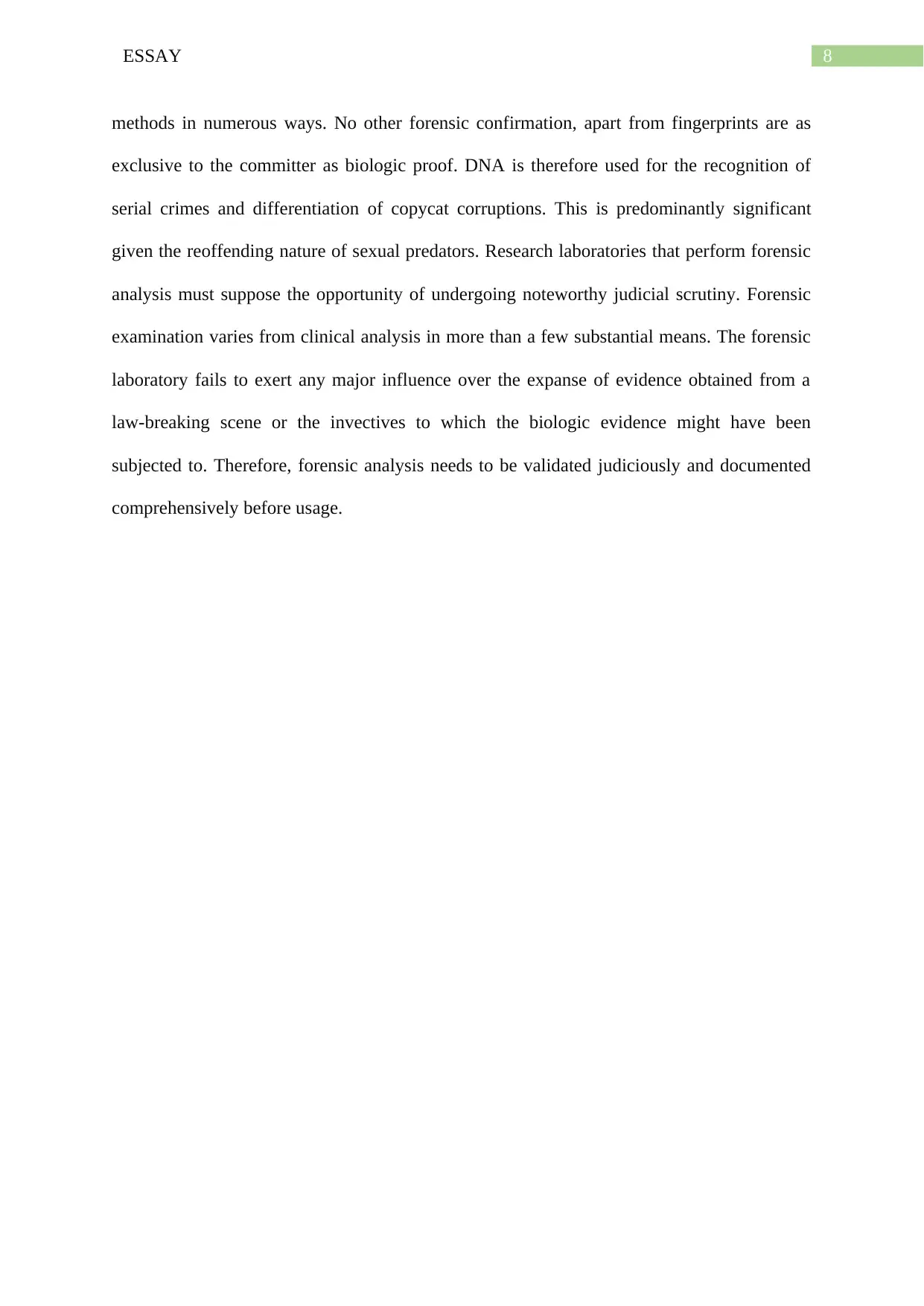
8ESSAY
methods in numerous ways. No other forensic confirmation, apart from fingerprints are as
exclusive to the committer as biologic proof. DNA is therefore used for the recognition of
serial crimes and differentiation of copycat corruptions. This is predominantly significant
given the reoffending nature of sexual predators. Research laboratories that perform forensic
analysis must suppose the opportunity of undergoing noteworthy judicial scrutiny. Forensic
examination varies from clinical analysis in more than a few substantial means. The forensic
laboratory fails to exert any major influence over the expanse of evidence obtained from a
law-breaking scene or the invectives to which the biologic evidence might have been
subjected to. Therefore, forensic analysis needs to be validated judiciously and documented
comprehensively before usage.
methods in numerous ways. No other forensic confirmation, apart from fingerprints are as
exclusive to the committer as biologic proof. DNA is therefore used for the recognition of
serial crimes and differentiation of copycat corruptions. This is predominantly significant
given the reoffending nature of sexual predators. Research laboratories that perform forensic
analysis must suppose the opportunity of undergoing noteworthy judicial scrutiny. Forensic
examination varies from clinical analysis in more than a few substantial means. The forensic
laboratory fails to exert any major influence over the expanse of evidence obtained from a
law-breaking scene or the invectives to which the biologic evidence might have been
subjected to. Therefore, forensic analysis needs to be validated judiciously and documented
comprehensively before usage.
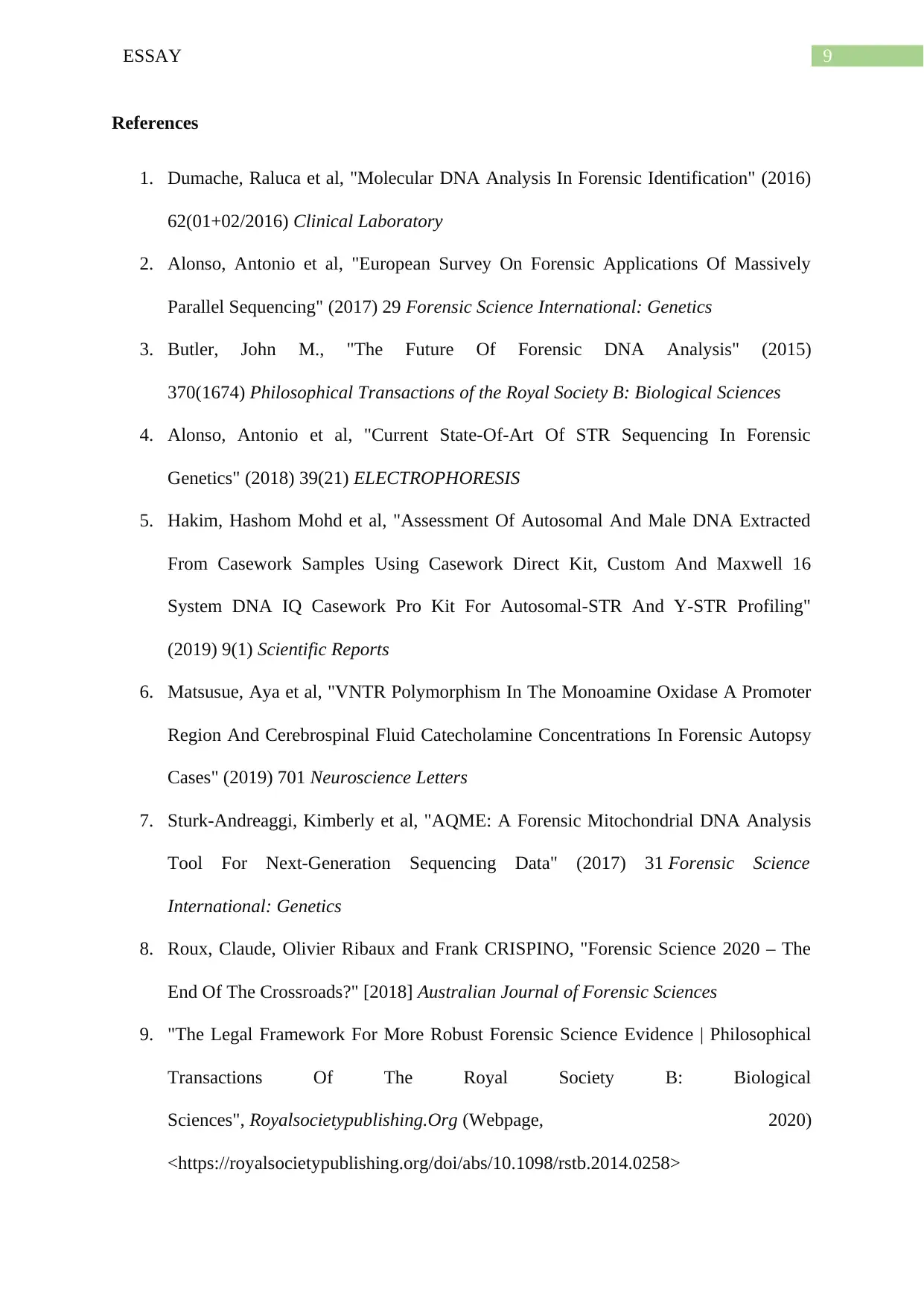
9ESSAY
References
1. Dumache, Raluca et al, "Molecular DNA Analysis In Forensic Identification" (2016)
62(01+02/2016) Clinical Laboratory
2. Alonso, Antonio et al, "European Survey On Forensic Applications Of Massively
Parallel Sequencing" (2017) 29 Forensic Science International: Genetics
3. Butler, John M., "The Future Of Forensic DNA Analysis" (2015)
370(1674) Philosophical Transactions of the Royal Society B: Biological Sciences
4. Alonso, Antonio et al, "Current State-Of-Art Of STR Sequencing In Forensic
Genetics" (2018) 39(21) ELECTROPHORESIS
5. Hakim, Hashom Mohd et al, "Assessment Of Autosomal And Male DNA Extracted
From Casework Samples Using Casework Direct Kit, Custom And Maxwell 16
System DNA IQ Casework Pro Kit For Autosomal-STR And Y-STR Profiling"
(2019) 9(1) Scientific Reports
6. Matsusue, Aya et al, "VNTR Polymorphism In The Monoamine Oxidase A Promoter
Region And Cerebrospinal Fluid Catecholamine Concentrations In Forensic Autopsy
Cases" (2019) 701 Neuroscience Letters
7. Sturk-Andreaggi, Kimberly et al, "AQME: A Forensic Mitochondrial DNA Analysis
Tool For Next-Generation Sequencing Data" (2017) 31 Forensic Science
International: Genetics
8. Roux, Claude, Olivier Ribaux and Frank CRISPINO, "Forensic Science 2020 – The
End Of The Crossroads?" [2018] Australian Journal of Forensic Sciences
9. "The Legal Framework For More Robust Forensic Science Evidence | Philosophical
Transactions Of The Royal Society B: Biological
Sciences", Royalsocietypublishing.Org (Webpage, 2020)
<https://royalsocietypublishing.org/doi/abs/10.1098/rstb.2014.0258>
References
1. Dumache, Raluca et al, "Molecular DNA Analysis In Forensic Identification" (2016)
62(01+02/2016) Clinical Laboratory
2. Alonso, Antonio et al, "European Survey On Forensic Applications Of Massively
Parallel Sequencing" (2017) 29 Forensic Science International: Genetics
3. Butler, John M., "The Future Of Forensic DNA Analysis" (2015)
370(1674) Philosophical Transactions of the Royal Society B: Biological Sciences
4. Alonso, Antonio et al, "Current State-Of-Art Of STR Sequencing In Forensic
Genetics" (2018) 39(21) ELECTROPHORESIS
5. Hakim, Hashom Mohd et al, "Assessment Of Autosomal And Male DNA Extracted
From Casework Samples Using Casework Direct Kit, Custom And Maxwell 16
System DNA IQ Casework Pro Kit For Autosomal-STR And Y-STR Profiling"
(2019) 9(1) Scientific Reports
6. Matsusue, Aya et al, "VNTR Polymorphism In The Monoamine Oxidase A Promoter
Region And Cerebrospinal Fluid Catecholamine Concentrations In Forensic Autopsy
Cases" (2019) 701 Neuroscience Letters
7. Sturk-Andreaggi, Kimberly et al, "AQME: A Forensic Mitochondrial DNA Analysis
Tool For Next-Generation Sequencing Data" (2017) 31 Forensic Science
International: Genetics
8. Roux, Claude, Olivier Ribaux and Frank CRISPINO, "Forensic Science 2020 – The
End Of The Crossroads?" [2018] Australian Journal of Forensic Sciences
9. "The Legal Framework For More Robust Forensic Science Evidence | Philosophical
Transactions Of The Royal Society B: Biological
Sciences", Royalsocietypublishing.Org (Webpage, 2020)
<https://royalsocietypublishing.org/doi/abs/10.1098/rstb.2014.0258>
Secure Best Marks with AI Grader
Need help grading? Try our AI Grader for instant feedback on your assignments.
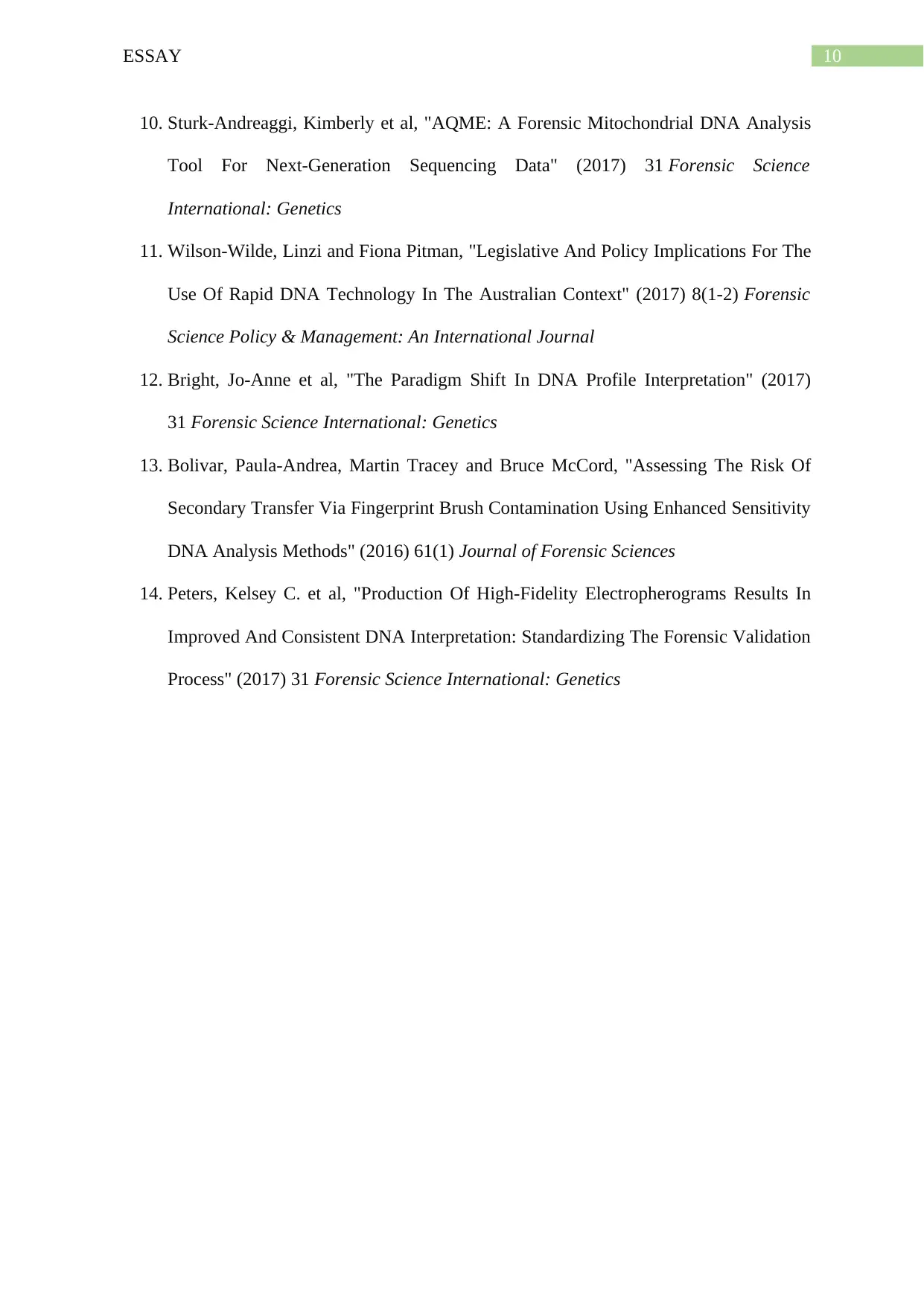
10ESSAY
10. Sturk-Andreaggi, Kimberly et al, "AQME: A Forensic Mitochondrial DNA Analysis
Tool For Next-Generation Sequencing Data" (2017) 31 Forensic Science
International: Genetics
11. Wilson-Wilde, Linzi and Fiona Pitman, "Legislative And Policy Implications For The
Use Of Rapid DNA Technology In The Australian Context" (2017) 8(1-2) Forensic
Science Policy & Management: An International Journal
12. Bright, Jo-Anne et al, "The Paradigm Shift In DNA Profile Interpretation" (2017)
31 Forensic Science International: Genetics
13. Bolivar, Paula-Andrea, Martin Tracey and Bruce McCord, "Assessing The Risk Of
Secondary Transfer Via Fingerprint Brush Contamination Using Enhanced Sensitivity
DNA Analysis Methods" (2016) 61(1) Journal of Forensic Sciences
14. Peters, Kelsey C. et al, "Production Of High-Fidelity Electropherograms Results In
Improved And Consistent DNA Interpretation: Standardizing The Forensic Validation
Process" (2017) 31 Forensic Science International: Genetics
10. Sturk-Andreaggi, Kimberly et al, "AQME: A Forensic Mitochondrial DNA Analysis
Tool For Next-Generation Sequencing Data" (2017) 31 Forensic Science
International: Genetics
11. Wilson-Wilde, Linzi and Fiona Pitman, "Legislative And Policy Implications For The
Use Of Rapid DNA Technology In The Australian Context" (2017) 8(1-2) Forensic
Science Policy & Management: An International Journal
12. Bright, Jo-Anne et al, "The Paradigm Shift In DNA Profile Interpretation" (2017)
31 Forensic Science International: Genetics
13. Bolivar, Paula-Andrea, Martin Tracey and Bruce McCord, "Assessing The Risk Of
Secondary Transfer Via Fingerprint Brush Contamination Using Enhanced Sensitivity
DNA Analysis Methods" (2016) 61(1) Journal of Forensic Sciences
14. Peters, Kelsey C. et al, "Production Of High-Fidelity Electropherograms Results In
Improved And Consistent DNA Interpretation: Standardizing The Forensic Validation
Process" (2017) 31 Forensic Science International: Genetics
1 out of 11
Your All-in-One AI-Powered Toolkit for Academic Success.
+13062052269
info@desklib.com
Available 24*7 on WhatsApp / Email
![[object Object]](/_next/static/media/star-bottom.7253800d.svg)
Unlock your academic potential
© 2024 | Zucol Services PVT LTD | All rights reserved.